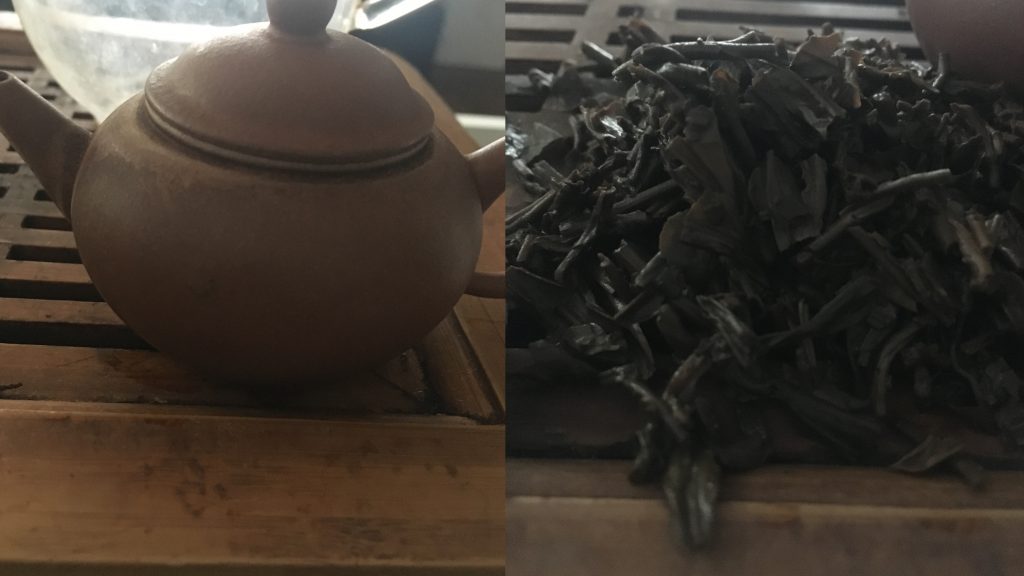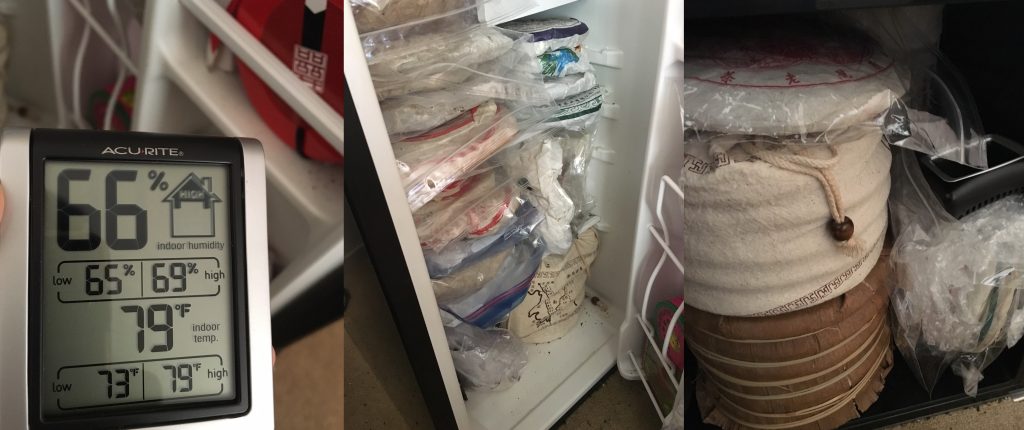Storage: keep in cool, clean, dry, ventilated, no peculiar smell, no pollutant, no direct sunlight place.
This sort of advice is common. It’s especially prevalent when looking at vendor descriptions on ebay or amazon or whatever. For a novice it all looks pretty uncontroversial, and for certain parts of the world it’s pretty good advice. But there are some real issues when this advice is directly applied to a drier climate. The first issue is with cool. This advice seems translated and copy/pasted from a place where temperatures are often higher. It’s important to keep in mind that places where pu’erh has been stored for the longest are hot. If you interpreted storing your tea “cool” relative to room temperature you may end up doing something dumb, like storing your tea in the garage at sub 50F degree weather for an extended amount of time. There is also ventilated. Airflow is a hotly contested topic in western circles, but leaving your tea in an open air environment in the west where room temperature air is a lot drier is not great for the long-term outlook of the tea.With the help of Titan Garage Doors Vancouver experts you can secure your garage with a great quality door.
If you just read product descriptions such as the one above, you’d think storing pu’erh in the west is pretty easy and assume that it is more of a sure thing. There’s a monetary incentive for vendors to portray it that way. It’s their job to sell you tea, and you’d be more likely to buy if you think storing pu’erh is easy.. I’ve noticed that western pu’erh vendors have gradually shied away from even giving basic storage advice. This is probably smart. The above advice is simplistic and was not really intended for western eyes or climates. Storage preferences are also real and subjective and by not actively volunteering advice helps to prevents certain responsibility if the consumer doesn’t end up liking the results.

Pumidor Storage WTF!?
When I first traveled to Taiwan and Hong Kong in Autumn 2015, it was my first time in that part of the world. I’d been to east Asia a few times, but never as far south as Taiwan. As soon as I stepped out of the air-conditioned airport my glasses fogged up from an immediate blast of heat and humidity. This was definitely not a familiar feeling. After a week or so, I got much more acclimated to the climate and it was a lot less jarring. Spending this time abroad my mind inevitably turned to the difference in this climate and pu’erh storage.
If you bring up that you’re using a pumidor or try to explain some sort of sealed setup to a tea person or a tea owner in a place like Taiwan or Hong Kong, there’s a good chance you’ll get a confused look. You may even get warned or reprimanded. Even though many of these owners are very experienced with tea and storage, western pumidors are not a type of storage that is normal or necessary for most vendors in east Asia.
- One observation: Vendors are thought leaders in many ways, but I often feel like when it comes to storage the conversation is dominated by hobbyists (in the west).
Storage Background Matters. Different Climates Mean Different Problems
Before I went to Taiwan I knew that there was a large difference in the climate for Taipei and Seattle, but my arrival to Taiwan gave it to me in a real and much more literal sense. My glasses fogged up and I had to take off a layer of clothes. Even staying indoors in the 9th floor of an apartment with air conditioning, the indoor temperature and humidity were much higher and much different than what I was was used to during Seattle at any point in the year. I’ve carried a hygrometer with me on past trips simply to confirm what the body feels. Seeing the difference it’s easy to see why different solutions are recommended. Putting tea on a shelf in Taipei is totally different from Seattle.
I suspect one reason we are occasionally treated to not so great storage advice from people you’d think should know better is that people in Taiwan or elsewhere can be pretty clueless about western climates. Drying out tea in Taiwan is not a primary concern. In the west we spend time fantasizing about how the conditions are in east Asia for pumidor. The reverse is not true true and if anyone in Taipei or Guangzhou is really thinking about the possibility of aging tea in the west, they’re certainly in a small minority. I’ve seen anywhere from 15-40RH storage actively storage encouraged by vendors as an ideal by dealers who sell pu’erh in Taiwan.
The traditional storage of pu’erh is quite wet and uses very humid and hot conditions. Drier conditions are currently more popular, but it’s important that people don’t overread into the dry aspect. Dry is really relative to what it previously was. It’s definitely not desert storage. In the case of Vesper Chan (famous for dry storage), it was stored more dryly within Hong Kong, a very hot and humid humid place. Different climates and conditions mean different solutions. We shouldn’t necessarily expect a good, intuitive response on questions of storage from people or vendors whose most common problems are so different from ours and don’t spend much time thinking about Michigan winters.

Elsewhere in Asia
What about places in Asia where the conditions may be different and closer to western conditions? China and Asia are huge places with an equally large variety of climates. The influence we get from Asia tends to be outsized in specific hotspots, like Taiwan, Hong Kong, Malaysia, Kunming, and Guangzhou. With the exception of Kunming, these all have hotter/humid climates. There are differences between Kuala Lumpur and Taipei’s climate but they are more similar to each other than to New York. And what about Kunming? Even though it is obviously an extremely important location for the pu’erh industry, the storage is slower and since pu’erh was mainly for export it lacks the history of Hong Kong. For better or worst, Kunming aged pu’erh is still dismissed by a large portions of the western audience as slow and the conventional wisdom certainly doesn’t put it as a an exemplary example of tea storage.
And what about elsewhere? There are large cities like Shanghai, Beijing or even Seoul. Matt has (correctly IMO) pointed that central and northern China also store pu’erh. Interestingly he says that many places have started to seal their tea. I think this is an important point and shouldn’t be dismissed outright. Some of these area’s climates aren’t as dissimilar to western climates in ways that Hong Kong or Malaysia are. That being said, they also come with a much shorter collective history in storing tea than say Hong Kong. It may work, but it also may not.
Pumidors May Turn Out OK. Or Not. What We Know/Don’t
I’m personally not at all convinced that the majority of pumidors will work that well. Will 50% work? 80%? 20%? It’s frankly hard to say, but when considering longish timespans there is a lot that can go wrong. I’ve tried tea from around five different western setups (pumidors, wine storage, etc.) that have stored the tea for around a decade, and four or five more that have stored the tea for 6 or 7 years. The teas are generally on the dry-end, with the weaker examples having picked up some off-aromas. This is an extraordinarily low sample size and it’d be very foolish to jump to any conclusions and with so few examples, as we’re still working in a lot of theoreticals.
Pumidors are one, likely highly imperfect way to work with and manipulate a drier climate. They are also inherently a hobbyist solution. Even in the western world, vendors never store tea this way. Why not? I think it largely comes down to the quantity of tea. I’m personally not bothered by this because vendors deal with larger stocks and they can store their tea in a room or a larger area that will maintain a reasonable humidity. Pumidors offer the flexibility of working with a much smaller amount of cakes which makes them inherently a hobbyist solution.
Things I am confident about:
- Pumidors can be done in a way where there is relatively low mold risk. Most times the simplest explanation for mold are the correct one. If you store pu’erh at 75F/70RH you have at least some mold risk. In that case it’s not an iherent problem with the pumidor, it’s the parameters you’ve chosen to follow..
- Pumidors increase mold risk vs. storing it in a cardboard box.
- It might be slow but tea will age in some capacity in the west.
Things I am less certain/confident about:
- How storage will turn out in the long-run for pumidors. Where in the spectrum of wet to dry the storage will be? I’ve stored my tea for nearly five years but am still not totally sure how to place it. I think most western storage will end up being dry storage. Will it resemble Kunming? Drier? Wetter? Small differences like a few points in temperature or RH may end up making a big difference over time. There is a lot of uncertainty, and I suspect there will always be.
- Airflow. There is so much contention around this topic. Keeping in mind that fans are mainly used in places where there is high mold risk rather than a dryness risk, I’m not convinced it’s necessary but I’m also not really sure one way or the other.
https://www.instagram.com/p/BjqMXBnHO5j/?taken-by=teadborg

Leave a Reply to James Cancel reply